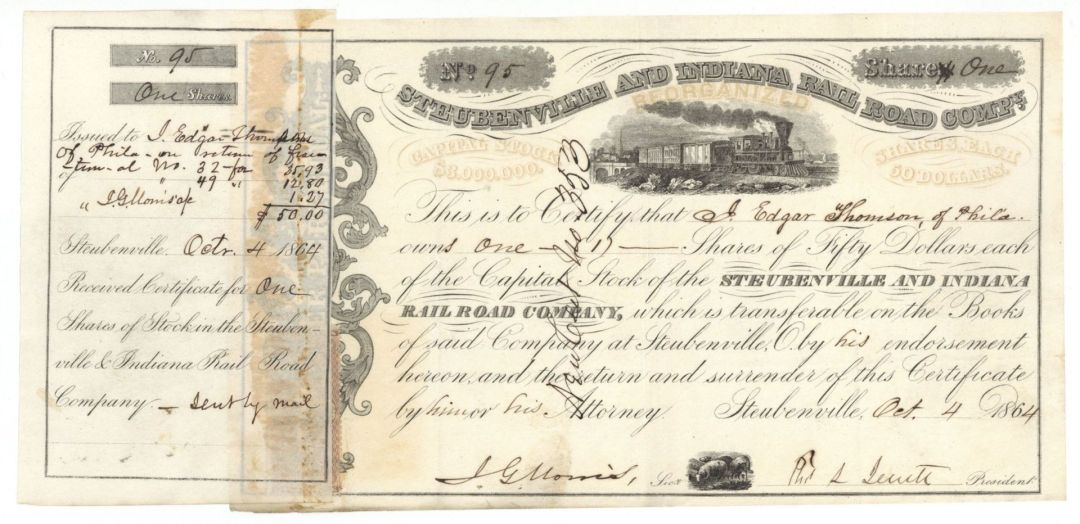Steubenville and Indiana Railroad Co. - 1864 dated Stock Certificate
Inv# RS4089 StockStock printed by Wm. Schuchman, Pittsburgh. Scarce! Bit of glue at left stub. Issued to J. Edgar Thomson, of Phil'd.

John Edgar Thomson (February 10, 1808 – May 27, 1874) was an American civil engineer and industrialist. An entrepreneur best known for his leadership of the Pennsylvania Railroad (PRR) from 1852 until his death in 1874, Thomson made it the largest business enterprise in the world and a world-class model for technological and managerial innovation. The railroad's first chief engineer became its third president. His sober, technical, methodical, and non-ideological personality had an important influence on the Pennsylvania Railroad, which in the mid-19th century was on the technical cutting edge of rail development. The railroad was known for its conservatism and steady growth while avoiding financial risks. His Pennsylvania Railroad became the largest railroad in the world, with 6000 miles of track, and was notable for generating steady financial dividends, for high-quality construction, constantly improving equipment, technological advances (such as replacing wood with coal as locomotive fuel), and innovation in management techniques for a large complex organization. Read more at https://en.wikipedia.org/wiki/John_Edgar_Thomson
The Steubenville and Indiana Railroad was chartered February 24, 1848, in Ohio to build west from the Ohio River at Steubenville to the Indiana state line between Willshire and Fort Recovery, via Mt. Vernon. On March 12, 1849, it was authorized to build a bridge at Steubenville and a branch to Columbus.
The first section opened December 22, 1853, from Steubenville west to Unionport. On February 2, 1854, an extension from Unionport west to Cadiz Junction opened; the branch to Cadiz opened June 12. Further extensions west from Cadiz Junction opened June 22 to Masterville, July 12 to Bowerston, and April 11, 1855, the rest of the way to Newark. However, it did not yet connect to any other railroads in Newark.
On December 25, 1854, the S&I came to an agreement with the Central Ohio Railroad to use its tracks from Newark west to Columbus. Some surveying had been done for a separate route via Granville. The connection at Newark opened April 16, 1857, and was built with funds provided by the Columbus and Xenia Railroad, which helped provide a through route to Cincinnati from the S&I. In 1864, the S&I outright bought a half interest in the Newark-Columbus track.
The Pittsburgh and Steubenville Railroad was chartered March 24, 1849, in Pennsylvania to build west from the Monongahela River near Pittsburgh to the Virginia (now West Virginia) state line towards the Steubenville and Indiana Railroad. It was authorized to extend across the Monongahela to Pittsburgh on April 21, 1852. The Western Transportation Company was incorporated by the Pennsylvania Railroad in Pennsylvania on March 15, 1856, to build and operate the P&S.
On July 22, 1853, the president of the S&I deeded right-of-way he had bought from 36 landowners across the Virginia Panhandle to the P&S. This allowed the railroad to build without a charter, which was required to use eminent domain; the powerful city of Wheeling had opposed the P&S, which bypassed Wheeling. The private Edgington and Wells Railroad (named after its owners, Jesse Edgington and Nathaniel Wells of Brooke County) opened July 4, 1854, but failed later that year, as it did not connect to any other railroads. The Holliday's Cove Rail Road was chartered by the Western Transportation Company on March 30, 1860, in Virginia to build across the Panhandle near what is now Weirton, West Virginia; the charter was only used to build the Steubenville Railroad Bridge. The next day the Wheeling Railroad Bridge Company was chartered by the same company, as a political promise to allow the incorporation of the HCRR.
The full P&S opened October 9, 1865, from Smithfield Street in Pittsburgh west to Wheeling Junction at the east end of the Steubenville Railroad Bridge. That same day, the Steubenville Railroad Bridge opened over the Ohio River, connecting the S&I and P&S, as did the connection at Pittsburgh, connecting the Pennsylvania Railroad with the P&S via the Monongahela River Bridge (commonly called the Panhandle Bridge) and Grant's Hill Tunnel. From then until 1868, the line was operated as the Pittsburgh, Columbus and Cincinnati Railroad by the Western Transportation Company.
The P&S was sold under foreclosure on November 6, 1867, to the Panhandle Railway, which had been chartered April 8, 1861. On April 30, 1868, the PHRy, S&I and HCRR merged to form the Pittsburgh, Cincinnati and St. Louis Railway, and the Western Transportation Company was dissolved soon after.
A stock certificate is issued by businesses, usually companies. A stock is part of the permanent finance of a business. Normally, they are never repaid, and the investor can recover his/her money only by selling to another investor. Most stocks, or also called shares, earn dividends, at the business's discretion, depending on how well it has traded. A stockholder or shareholder is a part-owner of the business that issued the stock certificates.











Ebay ID: labarre_galleries